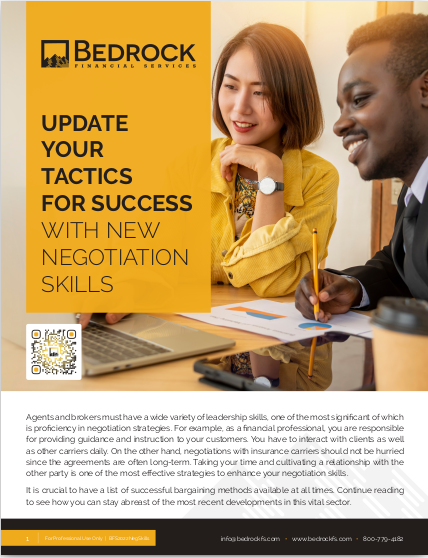Key Takeaways
-
Clients don’t respond well to pressure, but they do respond to empathy and clarity. Use planning sessions to open a dialogue, not to close a deal.
-
Human-first planning creates stronger client relationships, longer retention, and more organic referrals.
Why Pressure Doesn’t Work Anymore
You’ve probably seen it—or maybe even been taught it. Pressure tactics. Sales funnels. Urgency-driven closes. But here in 2025, that approach feels outdated. Clients are more informed, more skeptical, and far less likely to trust a conversation that sounds rehearsed or rigid.
Planning sessions shouldn’t feel like negotiations. They should feel like guidance. The client should walk away with more clarity, not more confusion or resistance.
People are bombarded by numbers every day—interest rates, inflation, premium comparisons. When you pile on more math without any meaning, you lose the one thing that sets you apart: the ability to connect.
The Value of Emotional Intelligence in Financial Conversations
Emotional intelligence isn’t just a soft skill. It’s a hard advantage. In a space dominated by numbers and projections, being the person who can listen, empathize, and respond with genuine intent makes you memorable.
When a client says, “I’m just not sure I’m ready,” the default reaction might be to fill the silence. But pausing and acknowledging the concern can lead to a more open conversation.
-
Ask open-ended questions.
-
Repeat back what you’ve heard to show understanding.
-
Match the client’s energy and tone.
Incorporating emotional intelligence doesn’t mean ignoring financial logic. It means making logic land in a way the client can actually hear.
Building a Planning Environment That Feels Safe
If your planning session feels like a high-stakes presentation, it’s time to rework the format. Clients open up when they feel safe, not sold to.
Here’s how to shift the tone:
-
Start without the numbers. Ask about lifestyle goals first.
-
Acknowledge complexity. Show that you understand planning isn’t always easy or straightforward.
-
Set shared expectations. Make it clear that your role is to help explore, not to pressure decisions.
When the environment feels safe, clients stop holding back. That’s when the real planning starts.
What Clients Actually Want From a Planning Conversation
Clients may come to you thinking they want a quote. But most are actually looking for:
-
Clarity about their current situation
-
Confidence that they won’t miss something important
-
A framework that helps them understand trade-offs
-
Someone who gets where they’re coming from
Your job is to surface those needs early. This keeps the conversation from spiraling into complexity or turning into a one-sided info dump.
A client might not know how to say, “I’m overwhelmed by options,” but they’ll respond well if you say, “There’s a lot out there. Let’s just look at what fits you—nothing else.”
Replace Pressure With Permission
Instead of jumping straight to a solution, ask for permission to explore possibilities. This subtle shift changes the dynamic.
Rather than, “Here’s what I recommend,” you say:
-
“Would it be helpful if we ran through two or three approaches together?”
-
“Want to look at a what-if scenario, just to see how it feels?”
-
“Can I show you something that’s helped others in your situation?”
That tone invites curiosity, not resistance.
The Role of Structure Without Rigidity
Structure doesn’t mean a script. It means having a flexible framework that can adapt based on the client’s energy, understanding, and needs. You can still guide the conversation—you just don’t need to control it.
A simple structure that works well:
-
Start with values: What’s most important to them in the next 5–10 years?
-
Look at reality: What’s already working, and where’s the friction?
-
Explore strategies: Show a few options without framing them as must-dos.
-
Check the fit: What feels like a maybe? What feels like a no?
-
Offer space: Give them time to process and revisit if needed.
This format encourages autonomy and prevents the session from feeling transactional.
Watch for the Moments That Matter
You’ll know the conversation is going well not by the number of questions you answer, but by the types of questions the client starts to ask. When someone says:
-
“Wait—can we back up a second?”
-
“What would that look like if I lost my job?”
-
“How would that affect my kids later on?”
That’s when you’re in. That’s when they’re starting to see you as a real partner.
Lean into those moments. Don’t rush past them to get back to the chart or the pitch. The human side is where the loyalty lives.
Drop the Assumptions, Not the Expertise
It’s easy to assume that clients want certainty. But what they really want is clarity.
Certainty feels too final. Clarity, on the other hand, is empowering.
Instead of saying, “This is the best plan,” try:
-
“Here’s one path that supports your goals.”
-
“Another option could work better if your income shifts.”
-
“This plan gives you flexibility, which seems to matter most to you.”
You’re still the expert. But the way you deliver that expertise determines how well it’s received.
Extend the Timeline Without Losing Momentum
Not every planning conversation should end with a decision.
In fact, some of your strongest relationships will start with a “not yet.”
Give clients space to digest. Let them know that their value to you isn’t tied to their readiness. If they come back three weeks later—or even three months—you’ve earned their trust by not rushing the process.
To maintain momentum:
-
Send a short email summary of what you discussed.
-
Share a one-page visual recap.
-
Offer to reconnect in a few weeks for updates.
This gentle follow-up shows you’re still thinking of them, without chasing a close.
Bring Humanity Into the Numbers
Numbers matter. But they’re not the full story. Help clients connect the data to their actual lives:
-
Instead of just saying, “You’ll save $X,” say, “That could mean an extra vacation with your family each year.”
-
Instead of “You’ll have $Y by 2035,” say, “That’s when your daughter starts college—this gives you options.”
People don’t dream in dollars. They dream in outcomes. Anchor the numbers in those outcomes.
The Long-Term Payoff of Pressure-Free Planning
A no-pressure approach doesn’t mean fewer conversions. It means more meaningful ones.
Here’s what it leads to:
-
Longer client retention—because they trust the process
-
Better referrals—because the experience was personal
-
Stronger renewals—because the plan actually fits
You may not close as fast. But the clients you do gain will stick around longer and bring others with them.
Staying Human Is a Strategy, Not a Soft Skill
In a world full of algorithms, automation, and AI-generated responses, the most powerful tool you have is your ability to stay human.
Planning isn’t just a numbers game. It’s a trust game. And trust is built through:
-
Consistent empathy
-
Active listening
-
Clear, pressure-free communication
If you can build a planning experience around those principles, you won’t just close deals—you’ll create loyalty that compounds over time.
Build a Practice That Clients Trust
If you’re ready to stop pushing and start guiding, we’re here to help. At Bedrock Financial Services, we help independent agents like you turn pressure-free planning into a sustainable, profitable business model.
Our support, technology, and training are all designed to help you stay human in a business driven by numbers. Sign up today and let’s build a better client experience together.







